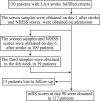Serum levels of galectin-1, galectin-3, and galectin-9 are associated with large artery atherosclerotic stroke
- PMID: 28112232
- PMCID: PMC5256273
- DOI: 10.1038/srep40994
Serum levels of galectin-1, galectin-3, and galectin-9 are associated with large artery atherosclerotic stroke
Abstract
The aim of this study was to assess the expression patterns of serum galectin-1 (Gal-1), galectin-3 (Gal-3), galectin-9 (Gal-9), and galectin-3 binding protein (Gal-3BP) and their associations with stroke outcome in large artery atherosclerotic (LAA) stroke. The serum levels of Gal-1, Gal-3, Gal-9, and Gal-3BP were measured by ELISA in 130 patients with LAA stroke and 130 age- and sex-matched controls. Serum samples were collected from the patients on day 1, day 6, and in the 4th week after ischaemic stroke (IS). An unfavourable outcome was defined as a modified Rankin Scale score of >2 on day 90 after IS. Our results indicated that the Gal-3 and Gal-9 levels were higher in patients with LAA stroke than in controls. A higher Gal-3 level was independently associated with an unfavourable outcome both on day 1 and day 6 after IS. In addition, Gal-9 and Gal-1 levels were upregulated on day 6 and in the 4th week after IS, respectively. For Gal-3BP, no difference was detected between patients and controls and no predictive value was found in patients. In conclusion, these findings suggest that the serum levels of Gal-1, Gal-3, and Gal-9 may be associated with LAA stroke.
Figures



References
-
- Perillo N. L., Marcus M. E. & Baum L. G. Galectins: versatile modulators of cell adhesion, cell proliferation, and cell death. J. Mol. Med. 76, 402–412 (1998). - PubMed
-
- Rabinovich G. A. Galectins: an evolutionarily conserved family of animal lectins with multifunctional properties; a trip from the gene to clinical therapy. Cell Death Differ. 6, 711–721 (1999). - PubMed
-
- Dhirapong A., Lleo A., Leung P., Gershwin M. E. & Liu F. T. The immunological potential of galectin-1 and -3. Autoimmun. Rev. 8, 360–363 (2009). - PubMed
-
- Barrionuevo P. et al.. A novel function for galectin-1 at the crossroad of innate and adaptive immunity: galectin-1 regulates monocyte/macrophage physiology through a nonapoptotic ERK-dependent pathway. J. Immunol. 178, 436–445 (2007). - PubMed
-
- Fusco O. et al.. 90K (MAC-2 BP) gene expression in breast cancer and evidence for the production of 90K by peripheral-blood mononuclear cells. Int. J. Cancer 79, 23–26 (1998). - PubMed
Publication types
MeSH terms
Substances
LinkOut - more resources
Full Text Sources
Other Literature Sources
Medical
Research Materials
Miscellaneous

